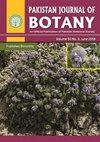巴基斯坦旁遮普省 Pothwar 地区花生(Arachis hypogea L.)根腐病病原体的生态学和形态学视角
IF 0.9
4区 生物学
Q4 PLANT SCIENCES
引用次数: 0
摘要
众所周知,土传病害是限制花生生产的重要因素之一。巴基斯坦对花生根腐病的研究很少。本次调查是为了评估花生根腐病在 Pothwar 地区三个县(即 Chakwal(Chakwal、Talagang)、Rawalpindi(Gujar khan)、Attock(Attock、Jand、Pindi gheb、Fateh Jang)的七个乡的发病率,并分离导致花生根腐病的植物病原真菌。结果显示,调查地区的花生根腐病发病率为 61.25%。两年期间,从 79 个村庄的 480 块农田中收集了 "265(265)"受感染的根茎样本。调查中发现,花生种植面积的 70% 以上都种植了易感根腐病的 334 号栽培品种。在 2019 年和 2020 年期间,阿托克县的发病率最高,分别为 14.2% 和 15.9%,而古杰尔汗县的发病率最低,分别为 8.0% 和 9.6%。从花生种植区共获得 104 个真菌分离物,其中有 Athelia rolfsii(49%),其次是 Fusarium fujikuroi(29.8%)和 Aspergillus terreus(21.2%)。Athelia rolfsii ( CHGR2a ) 的致病力最强,其次是 Fusarium fujikuroi (CHGRF5) 和 Aspergillus terreus (TGGR7)。对 334 号花生栽培品种的致病性试验表明,所有 104 个分离株都具有致病性,但其中 06 个分离株(PGGR6、CHGR2a、ATGR3、PGGR12、TGGR7 和 CHGRF5)具有高致病性。104 个分离株的病害发生率和严重程度值介于 15.33% 至 93.3% 和 13.53% 至 89.53% 之间。Athelia rolfsii、Fusarium fujikuroi 和赤霉病菌的发病率分别为 15.53% - 93.3%、24.4% - 88.9% 和 24.4% - 84.4%,而病害严重程度分别为 13.53% - 89.53%、19.7% - 84.2% 和 20.6% - 79.7%。本文章由计算机程序翻译,如有差异,请以英文原文为准。
Ecological and morphological perspectives of root rot pathogens of peanut (Arachis hypogea L.) in Pothwar region of Punjab, Pakistan
Soil borne diseases have been known as one of the significant limiting factors in peanut production. In Pakistan, little research has been done on peanut ( Arachis hypogea L.) root rot. The present survey was carried out for the assessment of disease incidence and isolation of phytopathogenic fungi causing root rot of peanut in seven tehsils of three districts of Pothwar regions viz., Chakwal (Chakwal, Talagang), Rawalpindi (Gujar khan), Attock (Attock, Jand, Pindi gheb, Fateh Jang) . Results revealed that root rot of peanut prevalence was 61.25% in surveyed area. "Two hundred and sixty-five (265)" infected roots samples were collected from 480 farmer’s fields of 79 villages during two years. During survey, it was observed that the root rot susceptible cultivar No.334 was grown in more than 70% cultivated area of peanut. The highest disease incidence was 14.2% and 15.9% in tehsil Attock, while the lowest was 8.0% and 9.6% in tehsil Gujarkhan during 2019 and 2020 respectively. A total of 104 fungal isolates were obtained from the peanut cultivation areas were Athelia rolfsii (49%) followed by Fusarium fujikuroi (29.8%) and Aspergillus terreus (21.2%). Athelia rolfsii ( CHGR2a ) had the utmost virulence followed by Fusarium fujikuroi (CHGRF5) and Aspergillus terreus (TGGR7). The pathogenicity test on peanut cultivar No.334 revealed that all the 104 isolates were pathogenic but among them 06 isolates (PGGR6, CHGR2a, ATGR3, PGGR12, TGGR7 and CHGRF5 were highly pathogenic. Disease incidence and severity values of 104 isolates varied between 15.33% to 93.3% and 13.53% to 89.53%. The disease incidence values of Athelia rolfsii, Fusarium fujikuroi and Aspergillus terreus ranged from 15.53% - 93.3%, 24.4%-88.9% and 24.4% - 84.4% while disease severity values ranged from 13.53% - 89.53%, 19.7% - 84.2% and 20.6% - 79.7% respectively.
求助全文
通过发布文献求助,成功后即可免费获取论文全文。
去求助
来源期刊

Pakistan Journal of Botany
生物-植物科学
CiteScore
2.40
自引率
8.30%
发文量
218
审稿时长
8.4 months
期刊介绍:
The Pakistan Journal of Botany is an international journal for publication of original research in plant science. Work on all plant groups, including fossil plants, is published. The journal publishes in the areas of: ecology and ecophysiology; conservation biology and biodiversity; forest biology and management; cell and molecular biology; paleobotany; reproductive biology and genetics; mycology and pathology; and structure and development.
 求助内容:
求助内容: 应助结果提醒方式:
应助结果提醒方式:


